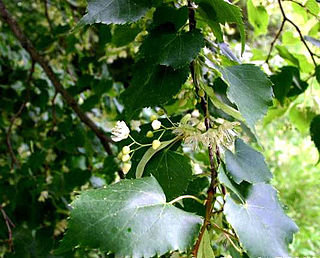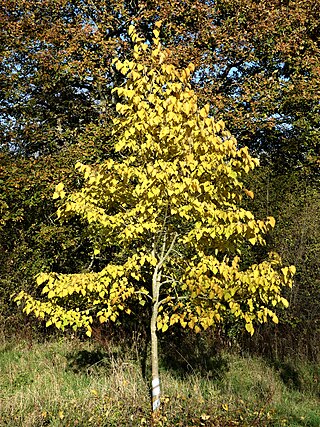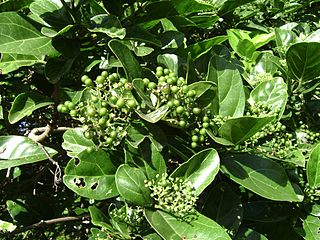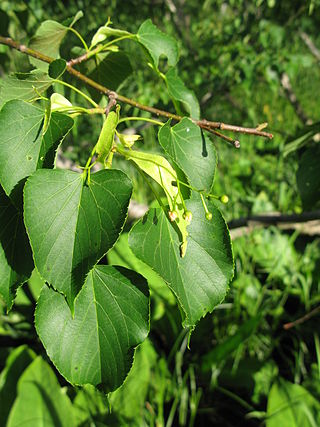
An inflorescence, in a flowering plant, is a group or cluster of flowers arranged on a stem that is composed of a main branch or a system of branches. An inflorescence is categorized on the basis of the arrangement of flowers on a main axis (peduncle) and by the timing of its flowering.

Tilia is a genus of about 30 species of trees or bushes, native throughout most of the temperate Northern Hemisphere. The tree is known as linden for the European species, and basswood for North American species. In Britain and Ireland they are commonly called lime trees, although they are not related to the citrus lime. The genus occurs in Europe and eastern North America, but the greatest species diversity is found in Asia. Under the Cronquist classification system, this genus was placed in the family Tiliaceae, but genetic research summarised by the Angiosperm Phylogeny Group has resulted in the incorporation of this genus, and of most of the previous family, into the Malvaceae.

Cornus is a genus of about 30–60 species of woody plants in the family Cornaceae, commonly known as dogwoods, which can generally be distinguished by their blossoms, berries, and distinctive bark. Most are deciduous trees or shrubs, but a few species are nearly herbaceous perennial subshrubs, and some species are evergreen. Several species have small heads of inconspicuous flowers surrounded by an involucre of large, typically white petal-like bracts, while others have more open clusters of petal-bearing flowers. The various species of dogwood are native throughout much of temperate and boreal Eurasia and North America, with China, Japan, and the southeastern United States being particularly rich in native species.

Tilia cordata, the small-leaved lime or small-leaved linden, is a species of tree in the family Malvaceae, native to much of Europe. Other common names include little-leaf or littleleaf linden, or traditionally in South East England, pry or pry tree. Its range extends from Britain through mainland Europe to the Caucasus and western Asia. In the south of its range it is restricted to high elevations.

Tilia platyphyllos, the large-leaved lime or large-leaved linden, is a species of flowering plant in the family Malvaceae (Tiliaceae). It is a deciduous tree, native to much of continental Europe as well as southwestern Great Britain, growing on lime-rich soils. The common names largeleaf linden and large-leaved linden are in standard use throughout the English-speaking world except in the British Isles, where it is known as large-leaved lime. The name "lime", possibly a corruption of "line" originally from "lind", has been in use for centuries and also attaches to other species of Tilia. It is not, however, closely related to the lime fruit tree, a species of citrus.

Ilex opaca, the American holly, is a species of holly, native to the eastern and south-central United States, from coastal Massachusetts south to central Florida, and west to southeastern Missouri and eastern Texas.

Alnus cordata, the Italian alder, is a tree or shrub species belonging to the family Betulaceae, and native to the southern Apennine Mountains and the north-eastern mountains of Corsica. It has been introduced in Sicily, Sardinia, and more recently in Central-Northern Italy, other European countries and extra-European countries, where it has become naturalised.

Houttuynia cordata, also known as fish mint, fish leaf, rainbow plant, chameleon plant, heart leaf, fish wort, or Chinese lizard tail, is one of two species in the genus Houttuynia. It is a flowering plant native to Southeast Asia. It grows in moist, shady locations. It was named after Martinus Houttuyn.

Aralia cordata is an upright herbaceous perennial plant growing up to 2 to 3 metres in height, native to Japan, Korea, Russian Far East, and eastern China. Its common names include spikenard, herbal aralia, udo, Japanese spikenard, and mountain asparagus. It is commonly found on the slopes of wooded embankments. Aralia cordata is a species of Aralia in the family Araliaceae.

Tilia americana is a species of tree in the family Malvaceae, native to eastern North America, from southeast Manitoba east to New Brunswick, southwest to northeast Oklahoma, southeast to South Carolina, and west along the Niobrara River to Cherry County, Nebraska. It is the sole representative of its genus in the Western Hemisphere, assuming T. caroliniana is treated as a subspecies or local ecotype of T. americana. Common names include American basswood and American linden.

Vitis amurensis, the Amur grape, is a species of grape native to the Asian continent. Its name comes from the Amur Valley in Russia and China.

Tilia × europaea, generally known as the European lime, common lime or common linden, is a naturally occurring hybrid between Tilia cordata and Tilia platyphyllos. It occurs in the wild in Europe at scattered localities wherever the two parent species are both native. It is not closely related to the lime fruit tree, a species of citrus.

Tilia tomentosa, known as silver linden in the US and silver lime in the UK, is a species of flowering plant in the family Malvaceae, native to southeastern Europe and southwestern Asia, from Romania and the Balkans east to western Turkey, occurring at moderate altitudes.

Tilia chingianaHu & W.C.Cheng is a medium-sized tree native to the provinces of Anhui, Jiangsu, Jiangxi, and Zhejiang in China.

Tilia henryanaSzyszyl., commonly known as Henry's lime, was introduced to the West from China by Ernest Wilson in 1901. The tree is native to the provinces of Anhui, Henan, Hubei, Hunan, Jiangsu, Jiangxi, Shaanxi, and Zhejiang, and was named for the Irish plantsman and sinologist Augustine Henry, who discovered it in 1888.

Premna serratifolia is a small tree/shrub in the family Lamiaceae. It flowers and fruits between May and November. During flowering season, it attracts a large number of butterflies and bees. Synonyms of Premna serratifolia Linn. include P. corymbosa Merr., P. integrifolia L. and P. obtusifolia R. Br.).

Tilia nasczokiniiStepanov, commonly known as Nasczokin's lime or Nasczokin's linden, is a rare deciduous tree or shrub endemic to Siberia in Russia.

Tilia mongolicaMaxim., commonly known as Mongolian lime, is a tree native to mountains of the northern China, growing up to elevations of 1200–2200 m.

Tilia carolinianaMill. is a species of tree in the family Malvaceae native to the southern and south-eastern states of the U.S., and Mexico.

Tilia japonica, the Japanese lime or Japanese linden, is a species of Tilia native to eastern China and Japan, preferring to grow in mountains up to 2000 m. It superficially resembles the better-known Tilia cordata, the small-leaved lime, and was originally described as Tilia cordata var. japonica. It differs from T. cordata in having 164 chromosomes instead of 82, and by some subtle differences in leaf and flower morphology. T. japonica inflorescences consistently have 5 staminodes, which is a reliable trait distinguishing it from T. cordata and T. amurensis. Recent studies indicate T.japonica to play an important role in maintaining the ectomycorrhizal networks in local forests it grows in Japan.




















